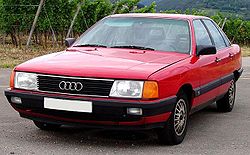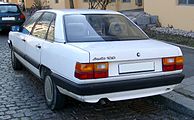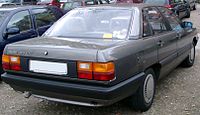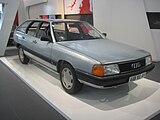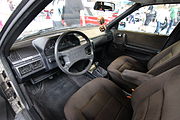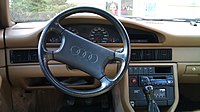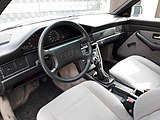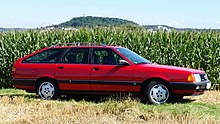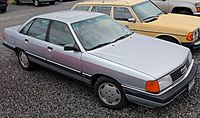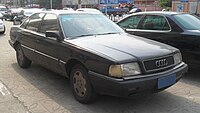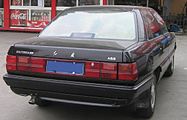Audi 100 C3
| Audi | |
|---|---|
|
Audi 100 (1982–1988)
|
|
| 100 C3 (type 44) | |
| Production period: | 1982–1991 (under license until 2004) |
| Class : | upper middle class |
| Body versions : | Limousine , station wagon |
| Engines: |
Otto engines : 1.8–2.3 liters (55–121 kW) Diesel engines : 2.0–2.5 liters (51–88 kW) |
| Length: | 4792 mm |
| Width: | 1814 mm |
| Height: | 1422 mm |
| Wheelbase : | 2685 mm |
| Empty weight : | 1080-1500 kg |
| Previous model | Audi 100 C2 |
| successor | Audi 100 C4 |
The Audi 100 C3 , also known internally and colloquially as the Type 44, was an upper mid-range vehicle model from Audi NSU Auto Union AG (from 1985: Audi AG). The Audi 100 C3 excelled with a particularly aerodynamically favorable body, was a pioneer of the permanent " quattro " all-wheel drive in the upper middle class and brought the TDI engine with diesel direct injection and turbocharger into series production for the Volkswagen group for the first time . When developing the Audi 100 C3, the main focus was on economy, high product quality and the vehicle's longevity. Ferdinand Piëch was in charge of the technical development of the Audi 100 C3 . The design came from Hartmut Warkuß . Today the Audi 100 C3 is an example of the beginning of the development of Audi into a technology-oriented premium brand.
Model history
Launch
In August 1982 the newly developed Audi 100 C3 (Type 44 ) came onto the market as the successor to the Audi 100 C2 (Type 43) that had been built since August 1976 .
The Audi research car presented at the 1981 IAA had already anticipated many of the features of the new Audi 100. The body of the C3 with the flush mounted, raised windows and a c w value of 0.30 was considered in the early 1980s as the most aerodynamically efficient series body this time and received many awards. Because of its lightweight construction and low air resistance, the car used less fuel than comparable vehicles of the time.
Audi research car , front view
In August 1983 the " Avant " station wagon with hatchback and the Audi 200 with the body and chassis of the Audi 100, but with a more powerful engine and better equipment, followed.
From November 1984 the "quattro" versions were available. The permanent all-wheel drive was provided with a medium differential gear. In a well-known commercial of the time, such a car drives up a snow-covered ski jump. The spot was later repeated with the Audi A6. During the shooting of the commercials, the cars drove up the hill on their own and were only secured with a wire rope.
As early as the mid-1980s, people experimented with aluminum bodies with which Audi 100 prototypes were equipped. However, the step into series production was only made with the later Audi A8 and its so-called “space frame” body.
Model upgrade with premiere of the TDI models
A major facelift took place in January 1988, as a result of which the Audi 100 received a redesigned interior as well as door handles fitted flush with the body and other small innovations. In addition to the seat belt tensioning system procon-ten , a driver airbag was now available. The five-cylinder engine was characteristic of this generation of the Audi 100 . A total of over 20 different engine variants between 51 kW (69 PS) (diesel) and 121 kW (165 PS) (turbo) were offered for the vehicle. The different equipment variants (basic, CC, CS and CD) were omitted.
The Audi 100 2.5 TDI was introduced in January 1990. After the Fiat Croma (1987) and the Austin Montego (1988), this was the third series production diesel car with direct injection . The 120 PS (88 kW) engine had a maximum torque of 265 Nm at 2250 rpm and low fuel consumption . Audi is considered to be a pioneer of this technology, which gave the Volkswagen Group a competitive advantage over its competitors in the 1990s. In the last model year there were still numerous special models until the Audi 100 Type 44 was finally replaced by the Audi 100 C4 in December 1990 . With the 2.4-liter diesel, the C3 was in production until the summer of 1991. The sister model Audi 200 was also produced until the summer of 1991, the Audi V8 derived from the 200 until mid-1994.
Many vehicles are now in the hands of enthusiasts or tuners, and many used vehicles have also been exported, a large number of which are still in use abroad. The C3 is considered to be a reliable and maintenance-friendly car. Thanks to the fully galvanized body from model year 1986, the Audi 100 C3 is almost immune to rust damage. The engines, especially the five-cylinder engines, are considered durable, and mileages of over 500,000 km are not uncommon.
Model variants
Overview of models and prices
| Models and prices Audi 100/100 Avant, Audi 200/200 Avant | |||||||
|---|---|---|---|---|---|---|---|
| Model name | Motorization | transmission | Order key |
Model year | |||
| 1988 | 1989 | 1990 | 1991 | ||||
| 01/01/1988 to 07/31/1988 44-J-200100 to 44-J-300000 |
08/01/1988 to 07/31/1989 44-K-000001 to 44-K-150000 |
08/01/1989 to 07/31/1990 44-L-000001 to 44-L-150000 |
08/01/1990 to 11/30/1990 44-M-000001 to 44-M-050000 |
||||
| from 01/29/1988 (100, 100 Avant, 200) |
from 07/04/1988 (100, 100 Avant, 200) |
from 12.09.1989 (100, 100 Avant) from 03.07.1989 (200) |
from 01/22/1990 (100 Avant) from 10/29/1990 (200) |
||||
| Recommended retail price of Volkswagen AG including VAT of 14% applicable from 07/01/1983 to 12/31/1992 | |||||||
| Petrol engines | |||||||
| 100 | 1.8 l / 66 kW | 5-speed (E) | 443 PP2 | 30,975 DM | 31,615 DM | 32,470 DM | |
| 100 | Automatic | 443 PP3 | 33,085 DM | 33,775 DM | 34,670 DM | ||
| 100 quattro | 5-speed | 443 PP5 | 42,250 DM | 43,090 DM | 40,170 DM | ||
| 100 Avant | 5-speed (E) | 445 PP2 | 33,780 DM | 34,465 DM | 35,375 DM | 36,370 DM | |
| 100 Avant | Automatic | 445 PP3 | 35,890 DM | 36,625 DM | 37,575 DM | ||
| 100 Avant quattro | 5-speed | 445 PP5 | 45,055 DM | 45,940 DM | 43,075 DM | ||
| 100 2.0 E | 2.0 l / 85 kW | 5-speed | 443 P44 | 35,260 DM | 35,975 DM | 37,185 DM | |
| 100 2.0 E | Automatic | 443 P43 | 37,370 DM | 38,135 DM | 39,385 DM | ||
| 100 Avant 2.0 E. | 5-speed | 445 P44 | 38,065 DM | 38,825 DM | 40,090 DM | 41,215 DM | |
| 100 Avant 2.0 E. | Automatic | 445 P43 | 40,175 DM | 40,985 DM | 42,290 DM | 43,475 DM | |
| 100 2.3 E. | 2.3 l / 100 kW | 5-speed | 443 PH4 | 35,980 DM | 36,705 DM | 39,955 DM | |
| 100 2.3 E. | Automatic | 443 PH3 | 38,090 DM | 38,865 DM | 42,155 DM | ||
| 100 quattro | 5-speed | 443 PH5 | 46,070 DM | 46,970 DM | 44,620 DM | ||
| 100 Avant 2.3 E. | 5-speed | 445 PH4 | 38,795 DM | 39,555 DM | 42,860 DM | 44,065 DM | |
| 100 Avant 2.3 E. | 3-stage automatic | 445 PH3 | 40,895 DM | 41,715 DM | 45,060 DM | 46,325 DM | |
| 100 Avant 2.3 E. | 4-step automatic | 46,840 DM | |||||
| 100 Avant quattro | 5-speed | 445 PH5 | 48,875 DM | 49,820 DM | 47,525 DM | 48,860 DM | |
| 100 turbo | 2.2 l / 121 kW | 5-speed | 443 P9G | 47,395 DM | 48,320 DM | 50,320 DM | |
| 100 turbo | Automatic | 443 P93 | 49,505 DM | 50,480 DM | 52,520 DM | ||
| 100 quattro | 5-speed | 443 P9F | 55,135 DM | 56,195 DM | 55,350 DM | ||
| 100 Avant turbo | 5-speed | 445 P9G | 50,200 DM | 52,165 DM | 53,225 DM | 54,720 DM | |
| 100 Avant turbo | 3-stage automatic | 445 P93 | 52,310 DM | 54,365 DM | 55,425 DM | 56,980 DM | |
| 100 Avant quattro | 5-speed | 445 P9F | 57,940 DM | 57,195 DM | 58,255 DM | 59,890 DM | |
| 200 turbo | 5-speed | 447 PB4 | 56,430 DM | 57,810 DM | 59,045 DM | 62,460 DM | |
| 200 turbo | Automatic | 447 PB3 | 58,540 DM | 59,970 DM | 61,245 DM | 64,790 DM | |
| 200 quattro | 5-speed | 447 PB5 | 65,800 DM | 67,340 DM | 65,760 DM | ||
| 200 Avant quattro | 5-speed | 447 DB5 | 68,605 DM | 70,190 DM | 68,665 DM | ||
| 200 quattro 20 V | 2.2 l / 162 kW | 5-speed | 447 P55 | 74,610 DM | 78,950 DM | ||
| 200 Avant quattro 20 V | 5-speed | 447 D55 | 77,515 DM | 82,050 DM | |||
| Diesel engines | |||||||
| 100 diesel | 2.0 l / 51 kW | 5-speed | 33,545 DM | ||||
| 100 diesel | Automatic | 35,545 DM | |||||
| 100 Avant diesel | 5-speed | 445 P6E | 36,395 DM | ||||
| 100 Avant diesel | Automatic | 445 P63 | 38,775 DM | ||||
| 100 diesel | 2.4 l / 60 kW | 5-speed | 443 PKE | 35,710 DM | |||
| 100 Avant diesel | 5-speed | 445 PKE | 38,615 DM | 39,700 DM | |||
| 100 turbo diesel | 2.0 l / 74 kW | 5-speed | 443 P5E | 37,735 DM | 38,735 DM | ||
| 100 Avant turbo diesel | 5-speed | 445 P5E | 40,585 DM | 41,640 DM | 42,810 DM | ||
| 100 TDI | 2.5 l / 88 kW | 5-speed | |||||
| 100 Avant TDI | 5-speed | 46,350 DM | |||||
Equipment variants
- Audi 100 (1982–1987)
- Audi 100 CC (1982–1987)
- Audi 100 CD (1982–1987) v. a. Velor seats and chrome trim
- Audi 100 CS (1982–1987) v. a. Sports chassis with 5-hole rims, sports seats
- Audi 100 Diesel (1982–1990) 51 kW naturally aspirated five-cylinder diesel
- Audi 100 turbo diesel (1982–1990) 64 or with charge air cooler 74 kW; Five-cylinder
- Audi 100 Turbo (1986–1990)
- Audi 100 2.0 (1988–1990)
- Audi 100 2.3 (1988–1990)
- Audi 100 2.3 (1990, sedan / Avant also as Sport II with 4-speed automatic)
- Audi 100 2.4 D (1988–1991) 60 kW naturally aspirated diesel
- Audi 100 2.5 TDI (01 / 1990-11 / 1990)
All models of the Audi 100 C3 were also available as an Avant and, if desired, with quattro permanent all-wheel drive, which was only available with a manual transmission. The “quattro” technology could only be combined with a four-speed automatic in the Audi V8.
Special models (selection)
In order to increase the attractiveness of the Audi 100 C3, which is already in its eighth model year, and to stabilize the falling sales figures, four special models with themed special equipment packages were offered at special prices from autumn 1989. The special models were called Audi 100/100 Avant " Business ", " Comfort ", " Sport " and " Reise und Hobby ". The special "Reise und Hobby" model was only available on the basis of the Audi 100 Avant.
- Special models Audi 100 C3
Audi 100/100 Avant Business
| Models and prices Special model Audi 100/100 Avant Business |
|||||||
|---|---|---|---|---|---|---|---|
| Model name | Motorization | transmission | Order key |
Model year | |||
| 1988 | 1989 |
1990 |
1991 | ||||
| 01/01/1988 to 07/31/1988 44-J-200100 to 44-J-300000 |
08/01/1988 to 07/31/1989 44-K-000001 to 44-K-150000 |
08/01/1989 to 07/31/1990 44-L-000001 to 44-L-150000 |
08/01/1990 to 11/30/1990 44-M-000001 to 44-M-050000 |
||||
| from September 1989 (100 Business, 100 Avant Business) |
|||||||
| Recommended retail price of Volkswagen AG including VAT of 14% applicable from 07/01/1983 to 12/31/1992 | |||||||
| Petrol engines | |||||||
| 100 | 1.8 l / 66 kW | 5-speed (E) | 443 PB2 W77 | 35,085 DM | |||
| 100 | Automatic | 443 PB3 W77 | 37,285 DM | ||||
| 100 quattro | 5-speed | 443 PP5 W77 | 42,170 DM | ||||
| 100 Avant | 5-speed (E) | 445 PB2 W80 | 38,550 DM | ||||
| 100 Avant | Automatic | 445 PB3 W80 | 40,750 DM | ||||
| 100 Avant quattro | 5-speed | 445 PP5 W81 | 45,635 DM | ||||
| 100 2.0 E | 2.0 l / 85 kW | 5-speed | 443 P44 W78 | 39,185 DM | |||
| 100 2.0 E | Automatic | 443 P43 W78 | 41,385 DM | ||||
| 100 Avant 2.0 E. | 5-speed | 445 P44 W81 | 42,650 DM | ||||
| 100 Avant 2.0 E. | Automatic | 445 P43 W81 | 44,850 DM | ||||
| 100 2.3 E. | 2.3 l / 100 kW |
5-speed | 443 PH4 W79 | 41,655 DM | |||
| 100 2.3 E. | Automatic | 443 PH3 W79 | 43,855 DM | ||||
| 100 quattro | 5-speed | 443 PH5 W79 | 46,320 DM | ||||
| 100 Avant 2.3 E. | 2.3 l / 100 kW | 5-speed | 445 PH4 W82 | 45,120 DM | |||
| 100 Avant 2.3 E. | 3-stage automatic | 445 PH3 W82 | 47,320 DM | ||||
| 100 Avant quattro | 5-speed | 445 PH5 W82 | 49,785 DM | ||||
| Diesel engines | |||||||
| 100 diesel | 2.4 l / 60 kW | 5-speed | 443 PKE W78 | 37,710 DM | |||
| 100 Avant diesel | 5-speed | 445 PKE W81 | 41,175 DM | ||||
| 100 turbo diesel | 2.0 l / 74 kW | 5-speed | 443 P5E W78 | 40,735 DM | |||
| 100 Avant turbo diesel | 5-speed | 445 P5E W81 | 44,200 DM | ||||
The special model Audi 100 / Audi 100 Avant "Business" had the following standard equipment:
- Interior in crayon
- 2 rear frame headrests
- central locking system
- Power steering
- Sliding / tilting roof with self-erecting wind deflector
- Electrically operated front windows
- Radio Beta with rear window antenna (sedan) or electronically reinforced roof antenna (Avant)
- Ski bag (limousine only)
- Roof rails (only Avant)
- Luggage compartment cover (only Avant)
- Rear window wiper with interval switching (only Avant)
Audi 100/100 Avant comfort
| Models and prices Special model Audi 100/100 Avant Comfort | |||||||
|---|---|---|---|---|---|---|---|
| Model name | Motorization | transmission | Order key |
Model year | |||
| 1988 | 1989 | 1990 | 1991 | ||||
| 01/01/1988 to 07/31/1988 44-J-200100 to 44-J-300000 |
08/01/1988 to 07/31/1989 44-K-000001 to 44-K-150000 |
08/01/1989 to 07/31/1990 44-L-000001 to 44-L-150000 |
08/01/1990 to 11/30/1990 44-M-000001 to 44-M-050000 |
||||
| from 01/22/1990 (100 Komfort / 100 Avant Komfort) |
|||||||
| Recommended retail price of Volkswagen AG including VAT of 14% applicable from 07/01/1983 to 12/31/1992 | |||||||
| Petrol engines | |||||||
| 100 2.0 E | 2.0 l / 85 kW | 5-speed | 443 P44 W84 | 43,274 DM | |||
| 100 2.0 E | 3-stage automatic | 443 P43 W84 | 45,534 DM | ||||
| 100 Avant 2.0 E. | 5-speed | 445 P44 W88 | 46,825 DM | ||||
| 100 Avant 2.0 E. | 3-stage automatic | 445 P43 W88 | 49,085 DM | ||||
| 100 2.3 E. | 2.3 l / 100 kW | 5-speed | 443 PH4 W85 | 46,114 DM | |||
| 100 2.3 E. | 3-stage automatic | 443 PH3 W85 | 48,374 DM | ||||
| 100 2.3 E. | 4-step automatic | 443 PH8 W85 | 48,889 DM | ||||
| 100 quattro | 5-speed | 443 PH5 W85 | 50,909 DM | ||||
| 100 Avant 2.3 E. | 5-speed | 445 PH4 W89 | 49,665 DM | ||||
| 100 Avant 2.3 E. | 3-stage automatic | 445 PH3 W89 | 51,925 DM | ||||
| 100 Avant 2.3 E. | 4-step automatic | 445 PH8 W89 | 52,440 DM | ||||
| 100 Avant quattro | 5-speed | 445 PH5 W89 | 54,460 DM | ||||
| 100 turbo | 2.2 l / 121 kW | 5-speed | 443 P9G W86 | 54,464 DM | |||
| 100 turbo | 3-stage automatic | 443 P93 W86 | 56,724 DM | ||||
| 100 quattro | 5-speed | 443 P9F W86 | 59,634 DM | ||||
| 100 Avant turbo | 5-speed | 445 P9G W90 | 58,015 DM | ||||
| 100 Avant turbo | 3-stage automatic | 445 P93 W90 | 60,275 DM | ||||
| 100 Avant quattro | 5-speed | 445 P9F W90 | 63,185 DM | ||||
| Diesel engines | |||||||
| 100 turbo D | 2.0 l / 74 kW | 5-speed | 443 P5E W83 | 44,711 DM | |||
| 100 Avant turbo D | 5-speed | 445 P5E W87 | 48,262 DM | ||||
| 100 TDI | 2.5 l / 88 kW | 5-speed | 443 PNE W83 | 48,385 DM | |||
| 100 Avant TDI | 5-speed | 445 PNE W87 | 51,936 DM | ||||
The special model Audi 100 / Audi 100 Avant "Comfort" had the following standard equipment:
- 5 light alloy wheels 6J x 14 in aero design (for 74 and 85 kW models) with 185/70 R 14 tires
- 5 light alloy wheels 6J x 15 in aero design (for 88, 98 and 121 kW models) with 205/60 R 15 V tires
- Large Audi rings on the boot lid
- Door handles in body color
- Bare cover on the bumpers
- Bare side bumper strips with the Audi emblem at the front
- Sliding / tilting roof with self-erecting wind deflector
- Interior in "velor"
- Luggage net on the back of the front seat backrests
- Wooden cover on the control panel and door panels
- Gear lever knob in wood with switching scheme (not automatic)
- Power steering
- Anti-lock braking system (ABS) (only included in models from 98 kW)
- 2 rear frame headrests
- Rear lap belt with retractor for middle rear seat
- central locking system
- 3 reading lights
- Switch-off delay for the interior and reading lights
- Windows front and rear, electric
- Passenger sun visor illuminated with makeup mirror
- 3 additional instruments in the dash panel: temperature display for engine oil, oil pressure display and voltmeter (not for 74 and 88 kW)
- Radio "gamma" with rear window antenna (sedan only)
- Radio "gamma" with electronically reinforced roof antenna (only Avant)
- Ski bag (limousine only)
- Roof rails (only Avant)
- Luggage compartment cover (only Avant)
- Rear window wiper with interval switching (only Avant)
- Metallic paint
Audi 100/100 Avant Sport
The special model Audi 100/100 Avant "Sport" was offered as part of the special or sales campaign "S711", internally also called "Sport II", from September 1989 for the 1990 model year and is now a popular special model variant among enthusiasts of the Audi 100 C3 (Type 44). The special "Sport" model differed visually through the flared fenders and exposed wheel arches, which were technically necessary when using the 15 "high-performance chassis with 215/60 R15 tires, but also a contemporary distinguishing feature of the Audi 200 quattro" Exclusiv " At that time one of the fastest series sedans in the world and became known through product placement in movies of the James Bond series or the series Die Schwarzwaldklinik .
The special model "Sport" is one of the equipment and sports packages "Sport Package I" and "Sports Package" also offered for model year 1990 II ”. The“ Sport Package II ”had the same equipment as the“ Sport Package I ”but also had the 15” high-performance chassis with 205/60 R15 tires, but without the wheel arches characteristic of the special “Sport” model.
| Models and prices Special model Audi 100/100 Avant Sport | |||||||
|---|---|---|---|---|---|---|---|
| Model name | Motorization | transmission | Order key |
Model year | |||
| 1988 | 1989 | 1990 | 1991 | ||||
| 01/01/1988 to 07/31/1988 44-J-200100 to 44-J-300000 |
08/01/1988 to 07/31/1989 44-K-000001 to 44-K-150000 |
08/01/1989 to 07/31/1990 44-L-000001 to 44-L-150000 |
08/01/1990 to 11/30/1990 44-M-000001 to 44-M-050000 |
||||
| from 01/22/1990 (100 Sport / 100 Avant Sport) |
|||||||
| Recommended retail price of Volkswagen AG including VAT of 14% applicable from 07/01/1983 to 12/31/1992 | |||||||
| Petrol engines | |||||||
| 100 2.3 E. | 2.3 l / 100 kW | 5-speed | 443 PH4 WA1 | 46,925 DM | |||
| 100 2.3 E. | 3-stage automatic | 443 PH3 WA2 | 49,185 DM | ||||
| 100 2.3 E. | 4-step automatic | 443 PH8 WA2 | 49,700 DM | ||||
| 100 quattro | 5-speed | 443 PH5 WA1 | 51,720 DM | ||||
| 100 Avant 2.3 E. | 5-speed | 445 PH4 WA5 | 50,476 DM | ||||
| 100 Avant 2.3 E. | 3-stage automatic | 445 PH3 WA6 | 52,736 DM | ||||
| 100 Avant 2.3 E. | 4-step automatic | 445 PH8 WA6 | 53,251 DM | ||||
| 100 Avant quattro | 5-speed | 445 PH5 WA5 | 55,271 DM | ||||
| 100 turbo | 2.2 l / 121 kW | 5-speed | 443 P9G WA3 | 56,157 DM | |||
| 100 turbo | Automatic | 443 P93 WA4 | 57,519 DM | ||||
| 100 quattro | 5-speed | 443 P9F WA4 | 60,429 DM | ||||
| 100 Avant turbo | 5-speed | 445 P9G WA7 | 59,708 DM | ||||
| 100 Avant turbo | 3-stage automatic | 445 P93 WA8 | 61,070 DM | ||||
| 100 Avant quattro | 5-speed | 445 P9F WA8 | 63,980 DM | ||||
The special model Audi 100 / Audi 100 Avant "Sport" had the following standard equipment:
- High-performance chassis
- Chassis 15 mm lower
- Sport seats in the front
- Fender flares front and rear
- Large Audi rings on the tailgate
- 3 additional instruments in the control panel: oil pressure display, voltmeter, temperature display for engine oil
- 5 light alloy wheels 7 1/2 J x 15 in aero design
- 215/60 ZR 15 tires
- Drive slip control (ASR) (only for 121 kW 5-speed front model)
- Gear lever knob in leather (not automatic)
- Gear lever gaiter in leather (not automatic)
- Power steering
- Anti-lock braking system (ABS)
- Windows front and rear, electric
- 4-spoke steering wheel with leather steering wheel rim
- Halogen headlights
- Sliding / tilting roof with self-erecting wind deflector
- 2 rear frame headrests
- Rear lap belt with retractor for middle rear seat
- Jacquard satin seat covers
- Radio "gamma" with electronically amplified roof antenna
- Ski bag (limousine only)
- Luggage compartment cover (only Avant)
- Roof rails (only Avant)
- Rear window wiper (only Avant)
- Metallic paint
| engine | |
| design type | Water-cooled five-cylinder in-line petrol engine with an overhead camshaft driven by a toothed belt, two valves per cylinder (OHC) and hydraulic valve lifters with hydraulic valve clearance compensation |
| Engine code | NF |
| Cubic capacity cm³ | 2309 |
| Power kW (PS) | 98 (133) at 5600 1 / min according to EG 80/1269, 100 (136) at 5600 1 / min according to DIN 70020 |
| Torque Nm | 186 at 4000 1 / min according to EG 80/1269, 190 at 4000 1 / min according to DIN 70020 |
| Bore / stroke mm | 82.5 / 86.4 |
| compression | 10.0: 1 |
| Mixture preparation | Mechanical-electronic injection system BOSCH KE-III-Jetronic with baffle plate air flow meter, fuel flow divider, idling stabilization valve, air-encased injection valves and fuel vapor retention system |
| Exhaust gas cleaning | Controlled three-way catalytic converter according to US standards with lambda probe |
| fuel | Super sulfur-free RON 95 according to DIN EN 228 (E5) or Super E10 sulfur-free RON 95 according to DIN EN 228 |
| Power transmission | |
| Drive type | Permanent four-wheel drive "quattro" of the second generation with automatically locking Torsen intermediate and manually lockable rear axle differential, distribution of the drive power to the front and rear axles in a ratio of 50:50 in the normal state with a maximum possible automatic redistribution in a ratio of 75:25 up to 25 : 75 of the drive force on the front and rear axles through the Torsen intermediate differential integrated in the manual transmission, transmission of the drive forces to the front axle via a hollow shaft integrated in the manual transmission, transmission of the drive forces to the rear axle via a multi-part cardan shaft with radial bearings to the manual from the driver to 100 % lockable rear axle transfer case |
| coupling | Single-disc dry clutch with hydraulic actuation |
| transmission | Fully synchronized, two-shaft gearbox with five forward and one reverse gears of type "01A-Allrad" with hollow shaft, Torsen distributor differential and electromechanical speedometer drive. The gearbox type "01A-Allrad" was derived from the 4- / 5-speed manual gearbox type "012" using the principle of common parts. The main changes were a three-part gearbox with a Torsen transfer case ("quattro" 2nd generation for longitudinally installed drives) in the rear, extended gearbox cover, the flange of the rear-axle cardan shaft and one from Audi developed hollow shaft (output shaft) with a pinion guided in it. The principle of automatically (partially) locking center differential of the "Torsen" type, with normal load distribution, transfers 50% of the drive force coming from the hollow shaft to the front axle via the pinion through the hollow shaft and 50% via the cardan shaft. Flange off the rear axle. The service life filling is 2.65 to 2.85 liters synthetic oil of the viscosity class SAE 75 / W90 (G50). |
|
Gear ratios (GKB: AAT / AML) |
1st gear: 3.545 |
| 2nd gear: 2.105 | |
| 3rd gear: 1.429 | |
| 4th gear: 1.029 | |
| 5th gear: 0.838 | |
| Reverse gear: 3,500 | |
| Final drive: 4.111 | |
| Braking system | |
| Art | Hydraulic dual-circuit brake system with axle-based distribution, disengageable anti-lock braking system with three-channel hydraulic unit, hydraulic brake booster with nitrogen-filled pressure accumulator, load and lateral acceleration-dependent brake force regulator on the rear axle |
| Execution in front | Internally ventilated disc brake 276x25 mm, Ate 57 floating caliper with brake pad wear indicator |
| Rear version | Disc brakes 245x10 mm, Girling 38 fist saddle system with integrated, mechanical pull-wire parking brake that acts on the brake piston, automatic adjustment |
| landing gear | |
| Front axle | MacPherson strut axle on a rubber-mounted subframe, wishbone forming wishbones and stabilizer, track stabilizing scrub radius, strut with shock absorber insert |
| Rear axle | Four-joint trapezoidal link rear axle with front and rear cross members as well as suspension struts and stabilizer |
| steering | Hydraulically assisted rack and pinion steering, safety steering column with cable pull system |
| bikes | Wheel rims 7.5J x 15, ET35 with bolt circle LK 5/112 with tires 215/60 R15 93V |
| body | |
| CW value | 0.30 (sedan with 1.8-liter engine) 0.33 (Avant with 1.8-liter engine) |
| execution | Self-supporting safety passenger cell in conventional shell construction made of sheet steel galvanized on both sides with front axle subframe, bonded front and rear window made of laminated glass, unscrewable front fenders and front section, doors with aluminum side window guides integrated into the unit carrier, flush with the body (inner door parts) and outer door parts made of sheet steel -Construction |
| Occupant protection | Maintenance-free, purely mechanical, via the unit shift in a vehicle frontal collision from approx. 20 km / h operating cable and Bowden cable system "procon-ten" to retract the corrugated pipe safety steering column (procon) and tighten the belts of both front seats (-ten ) |
| Tank capacity L | 80 |
| Electrics | |
| Art | Splash-proof central electrics in the water tank with additional relay station behind the control panel |
| ignition | Fully electronic, diagnosable map ignition with selective knock and lambda control and Hall sender ignition distributor |
| On-board voltage V | 12 |
| Battery Ah / A | 63/300 |
| Alternator A. | 90 (110, for vehicles with air conditioning) |
| Dimensions (sedan, avant) | |
| Length mm | 4792 |
| Width (mm | 1814 |
| Height mm | 1414 |
| Overhangs mm | 1016 (front), 1088 (rear) |
| Ground clearance mm | 117 |
| Wheelbase mm | 2688 |
| Gauges mm | 1497 (front), 1511 (rear) |
| Turning circle diameter m | 11.5 |
| Luggage compartment dimensions (Avant) | |
| Volume L | 2025 (according to ball measurement), 1837 (according to VDA cuboid measurement) |
| Length mm | 1059 (on the floor, bench raised), 1994 (on the floor, bench folded down) |
| Width (mm | 1209 (maximum), 1112 (between the wheel arches) |
| Height mm | 746 (up to headliner) |
| Width of tailgate cutout mm | 956 (top), 956 (bottom) |
| Height of tailgate cutout mm | 802 (middle) |
| Weights | |
| Permissible total weight kg | 1910 (sedan), 1950 (Avant) |
| Empty weight ready for operation kg | 1360 (sedan), 1400 (Avant) |
| Load kg | 550 (sedan), 550 (Avant) |
| Performance (quattro / manual transmission) | |
| Top speed km / h | 201 (sedan), 199 (Avant) |
| Acceleration 0 to 80 km / h sec | 6.7 (sedan), 6.8 (Avant) |
| Acceleration 0 to 100 km / h sec | 10.0 (sedan), 10.2 (Avant) |
| Consumption l / 100 km (according to ECE A 70) | |
| at a constant 90 km / h | 6.9 (sedan), 7.2 (Avant) |
| at a constant 120 km / h | 8.8 (sedan), 9.3 (Avant) |
| in the city cycle | 11.9 (sedan), 11.9 (Avant) |
| Recommended retail price of the manufacturer (incl. 14% VAT, model year 1991) | |
| Limousine DM | 51,720 |
| Avant DM | 55.271 |
Hybrid vehicle "Audi duo"
Based on the Audi 100 Avant quattro (C3), Audi presented a series-ready vehicle with hybrid drive, the Audi duo , developed in collaboration with Pöhlmann KG (Kulmbach) at the Geneva Motor Show in March 1990 .
The first generation of the hybrid drive from Audi had a conventional 2.3-liter five-cylinder internal combustion engine with 100 kW (136 hp) to drive the front wheels, as well as a 60 kg, fan-cooled DC motor instead of the cardan shaft, which can be used as required could be switched on to drive the rear wheels. The electric motor had an output of 9.3 kW (12.6 hp), which was supplied by a 181 kg package of 54 series-connected nickel-cadmium batteries including a charger. The nickel-cadmium high-performance batteries stored 1.2 volts per cell and offered a total voltage of 58.8 volts. The batteries were housed in the spare wheel well and were ready for use again in 45 minutes with quick charge. The batteries could also be recharged while driving. The range of the batteries gave the Audi duo a range of around 30 km. The maximum speed in electric mode was 50 km / h. The combustion engine could be started with the ignition key or, after switching to idling, the electric drive could be activated by pressing an "E" key. The steering and braking assistance worked with another electric motor. A petrol-electric hot water heater provided warmth in the interior if required.
The additional expense compared to a conventionally powered vehicle was around 25,000 D-Marks. The target group of the Audi duo were municipalities, utility companies or driving services with transport tasks in quiet zones or in the event of a smog alarm. In the end, there were only three prototypes, as there was hardly any demand for series production.
Audi showed the second generation of the hybrid drive in March 1992 at the Geneva Motor Show based on an Audi 100 Avant quattro (C4) with a gasoline engine and a water-cooled, permanently excited three-phase synchronous motor and a sodium-sulfur battery. Only a few vehicles were built for selected customers and for research purposes.
The third generation of the hybrid drive developed for series production based on an exclusively front-wheel drive Audi A4 Avant (B5) with diesel TDI engine, water-cooled three-phase synchronous motor and lead batteries was shown at the AAA in Berlin in September 1996. 90 vehicles of the third generation Audi duo were built in series. In April 1997 a fleet test began in Erlangen.
Fully galvanized
Already when the Audi 100 C3 (Type 44) was introduced, sheet metal that was electrolytically galvanized on one and both sides, hot-dip galvanized on both sides, galvanized and tin-crometal-coated sheets was used for approx. 35% of the body. From September 1985, for the 1986 model year, the series received a fully galvanized body. For the invisible parts of the floor pan such as B. the entire front end and the one-piece floor pan on both sides hot-dip galvanized sheets and for the attachments lying in the visible area, because of the better surface quality, such. B. front flap, fenders, doors and tailgate on both sides electrolytically galvanized sheet metal used. The zinc layer on the entire body weighs approx. 5 kg. The previous corrosion protection measures such as zinc phosphating , cataphoretic immersion primer , PVC underbody protection and seam sealing , elastic stone chip protection filler and hot flood wax preservation were fully retained. When it comes to the manufacture of fully galvanized bodies, Audi was able to benefit from experience in the custom-made production of the Porsche 924 and 944 at the Neckarsulm plant and took on a pioneering role in large-scale production. The first introduction of fully galvanized bodies in large-scale production at Audi resulted from long-term driving tests that have been carried out since 1975 in corrosion-critical environments such as in the vicinity of the lake district in the Canadian-American border region with acid rain , minus temperatures of 40 degrees and the associated use of aggressive de-icing salts or were carried out in Florida with a particularly thin ozone layer or strong UV radiation in connection with a highly salty sea air. In addition, there were tests in what was then the world's most modern testing facility, the Audi Corrosion Protection Center in Ingolstadt, which was commissioned in 1982 at a cost of DM 12.5 million. The core of the investigations was the so-called "30-cycle test" (now the INKA test), which was carried out in a three-chamber system. This made it possible to trace all corrosion conditions within 14 weeks that corresponded to a vehicle service life of six years. For this purpose, a year before series production, tool-made vehicles were tested for four days, 16 hours a day over a total distance of 2000 km on a test site in Ehra-Lessien on vibrating, slag, sand and gravel routes in salt water and mud passages as well as with artificial damage preconditioned like scratches and dents in order to expose the vehicles to corrosion-critical influences in the salt spray, climatic and vibrating cold chambers.
Aerodynamics world champion
Aerodynamics world champion (also: c w world champion) is a term initially coined by motor journalists and later adopted by Audi for their press work for the achievement of a particularly low drag coefficient (c w value) for a certain vehicle model, which has been the special since the market launch of the aerodynamically efficient vehicle model Audi 100 C3 is used in 1982. The drag coefficient is the focus of the press and vehicle manufacturers in order to demonstrate particularly good economic efficiency or acoustics of a newly developed vehicle model. The average c w value of all cars built in Europe was over 0.4 in 1982. A ten percent improvement in the drag coefficient results in a gasoline saving of around four percent. In the meantime, the designation was used by motor journalists for the Opel Kadett E and Opel Calibra . The name Mercedes has been used for the Mercedes CLA and Mercedes A-Class models since 2012 .
| model | year | CW value |
|---|---|---|
| Audi 100 C3 | 1982 | 0.30 |
| Opel Kadett E. | 1984 | 0.30 |
| Opel Calibra | 1989 | 0.26 |
| Mercedes CLA | 2013 | 0.23 |
| Mercedes A-Class | 2018 | 0.22 |
All-aluminum body
After the, in 1978 developed Audi car research , the use of some so-called Hang on body parts such. B. front hood, fenders, doors and door subframes made of aluminum or aluminum composite materials was tested and Porsche was already tested in September 1981 at the International Motor Show IAA , as part of the research project "long-term car" and in cooperation with the aluminum manufacturer and processor Alusuisse developed the all-aluminum body of the Porsche 928 , weighing only 161 kg , Audi decided at the end of 1981 to develop an all-aluminum body for large-scale production in a collaboration with Alcoa that was initially kept secret . The actual project work started in mid-1982 and the preliminary development phase ended at the end of 1984 with the completion of a prototype body for the Audi 100 C3 Type 44 and the Audi 80 B3 Type 89 in conventional shell construction. In May 1985, 4 1/2 years after Porsche, the approx. 149 kg prototype body of the Audi 100 C3 Type 44 in aluminum shell construction was exhibited by Alcoa at the Hanover Fair . The testing of the bodies confirmed the fear that simply replacing the material would result in a reduction in weight, but would result in disadvantages in terms of material fatigue, corrosion behavior and acoustics and the development of a completely new technology that also lives up to the claim of the slogan Vorsprung durch Technik , is necessary. At the same time as the 1985 Hanover Fair, Audi was already working on bodies in Ingolstadt in the more innovative aluminum frame structure, but it was not until the spring of 1989 that it was able to make the decision to bring the newly developed technology into large-scale production in a luxury-class vehicle, the Audi A8 D2 from 1994 .
Economy drive Audi 100 TDI and engine concept TDI
In August 1989, an Audi 100 C3 vehicle that was optimized for the lowest possible fuel consumption, but was largely series-produced, was driven by Audi, notarized and accompanied by TÜV Heilbronn, a total of 4,818.4 kilometers through several European countries. The aim was to achieve the maximum driving distance for the vehicle on one tank of fuel. 84.667 liters of diesel fuel were used. This results in an average consumption of 1.76 liters per 100 kilometers. The experiment lasted 80.05 hours. That gives an average speed of 60.2 kilometers per hour.
The optimizations for the lowest possible consumption on the vehicle were a tire air pressure increased to 4 bar, the dismantling of the right exterior mirror for lower air resistance and a 20% longer gear ratio for a just acceptable cruising speed of 60 km / h at an engine speed of 1,100 1 / min. According to Audis, the record was primarily achieved by a trained driver choosing an economical route on motorways with few mountains and a very fuel-efficient driving style with the air conditioning switched off and windows closed. Sometimes the engine was switched off when driving downhill.
A new, 2.5 liter (displacement) five-cylinder diesel engine with fully electronically controlled direct diesel injection, turbocharger with map-controlled charge pressure control, charge air temperature-dependent charge air cooling, electronic accelerator pedal or pedal value transmitter and Electronically controlled hydraulic engine mount which was one of the most important developments in the engine sector for Audi in recent years and as a possible answer to some future problems. The engine in the record-breaking vehicle had an output of 120 hp (88 kW) at 4250 rpm and a torque of 265 Nm at 2250 rpm. The consumption of the vehicle was specified in the so-called third mix according to DIN 70020 with 5.7 liters per 100 kilometers. The acceleration capacity was given as 10 seconds for the achievement of 100 km / h and the achievable top speed as 200 km / h.
The achievement of this record served at the 53rd International Motor Show September 14th to 24th 1989 in Frankfurt am Main as an effective promotional support for the introduction of the new TDI diesel engine concept from Audi, according to its own statement, the "first car turbo-diesel direct injection of the second generation "and" world champion in its class ".
During a test drive organized by Audi on the Hockenheimring in the winter of 1990, representatives of the press noticed that the vehicle had further optimized fuel consumption. These were a vehicle model selected with low overall rolling resistance (presumably), a moderate lowering of the chassis, a partial covering of the radiator grille, an optimized wheel alignment, the removal of approx. 20 kg of insulation material from the vehicle, an electric instead of hydraulic braking assistance and a low power generator. On the engine itself, reduced compression, a changed injection point, smaller injection nozzles, increased boost pressure, the use of a particularly smooth-running winter engine oil, special reworking of the crankshaft and piston connecting rods as well as the intake pipe to optimize consumption. During the test drive on the Hockenheimring, press representatives determined a consumption of 3.52 liters of diesel fuel per 100 kilometers. The vehicle was moved over 10 laps, about 60 km at a constant speed of 90 km / h in 42 minutes.
The new diesel engine concept was launched in February 1990 as the Audi 100 TDI in the Audi 100 C3. The Audi 100/100 Avant TDI (C3) was produced a total of 4,764 times between 1989 and 1991. In the successor model Audi 100/100 Avant (C4), the new diesel engine concept was produced a total of 51,464 times up to 1994.
Around mid-2019, 30 years after the economy drive of the Audi 100 TDI in August 1989, triggered by the political and popular discussion about the automotive industry, the diesel engine, driving bans for vehicles with diesel engines and, last but not least, the "diesel scandal" in the Volkswagen Group, came about it to the opinion that this forward-looking engine concept or forward-looking (diesel) engine concepts in general would have been prevented by a lobby from the oil industry and / or the automotive industry.
Advertising and press
Commercial "Schanze"
At the end of 1985, the "Schanze" commercial, which has now become legendary and won a Golden Lion at the International Advertising Film Festival in Cannes, was produced by the Düsseldorf advertising agency team / BBDO in cooperation with their production company TV Company.
A tornado-red, weight-reduced Audi 100 CS quattro of type 44 (C3) with 136 hp, equipped with spiked tires, drove up the Pitkävuori ski jump in Kaipola, Finland. The vehicle was secured by a rope brake against slipping back and the inevitable fall.
The commercial was published in the spring of 1986 in a 66-second version in the support program of German cinemas and in a version shortened to 30 seconds on German advertising television.
To this day there is a discussion about whether the safety rope visible in a short scene of the commercial was not only used to secure the vehicle, but also to pull it up. However, this can be refuted by the facts at hand, including the "making of" of the commercial and the statement by driver Harald Demuth contained therein.
In January 2005, on the occasion of the 25th anniversary of the “quattro” drive technology, the idea was picked up again and, with dramaturgical borrowings from the original from 1985, a new commercial “Schanze 2005” by Audi itself, without the support of an agency, on which meanwhile disused Pitkävuori ski jump in Kaipola, which is in need of renovation. This time an atlas gray Audi A6 4.2 quattro of type 4F (C6) with 335 hp drove up the hill.
In 2019, scenes from the now legendary commercial from 1986 were used for a video clip on the fully electric technology platform “Audi e-tron extreme”.
Export models and license production
North America, South Africa and Japan
In North America, the Audi 100 C3 was offered from 1983 to 1988 under the name Audi 5000 introduced in the previous model ; from 1988 onwards the names Audi 100 and 200, which are common in Europe, were used again.
In South Africa, Volkswagen South Africa manufactured the Audi 100 using the CKD process and offered it under the name Audi 500.
In Tokyo, the C3 was assembled until November 1991, as the Audi 200 until July 1992.
USA version of the Audi 100: the Audi 5000
Made in China
Under the name Hongqi (“Red Flag”), the C3 was produced in China from 1988 to 2004 under license from the FAW in Changchun as a representative limousine, sometimes with exotic body variants, even as a four-door convertible .
The Audi 100 rolled off the assembly line in 1992 in a joint venture called FAW-Volkswagen . Initially, CKD kits from South African manufacture were used for assembly . At that time the model code 443 was in use. From 1994, when the in-house production of components began, the model code 4A2 was then in use. There were four different engines to choose from. The entry-level model had the 1.8 liter engine with an output of 66 kW (1781 cm³, 90 hp). The second stage was the 2.0 with an output of 79 kW (1984 cm³, 107 PS). The 2.2i with 96 kW (2226 cm³, 131 PS) was a bit higher. The top engine was the 2.6 l engine, which had an output of 102 kW (2598 cm³, 139 hp). From 1995 there were then the top models with a new engine. From now on, the 2.6i with an output of 110 kW (2596 cm³, 150 PS) was installed, which had previously only been used in the Hongqi sedans. In the course of 1999, production of this Chinese Audi finally ended.
Engines
Otto
| model | Displacement (cm³) | Code letter | Engine type | power | Torque | comment | construction time |
|---|---|---|---|---|---|---|---|
| Four-cylinder | |||||||
| 1.8 | 1781 | DR | Carburetor | 55 kW (75 PS) | 140 Nm | without cat | 08.1982-12.1987 |
| 1.8 | 1781 | SH | Carburetor | 65 kW (88 PS) | 146 Nm | also as quattro, catalytic converter | 02.1986-07.1990 |
| 1.8 | 1781 | 4B | Monojetronics | 66 kW (90 PS) | 142 Nm | catalyst | 01.1988-09.1989 |
| 1.8 | 1781 | DS | Carburetor | 66 kW (90 PS) | 145 Nm | without cat | 08.1983-07.1989 |
| 1.8 | 1781 | PH | KE-Jetronic | 66 kW (90 PS) | 137 Nm | also as quattro, catalytic converter | 04.1985-12.1990 |
| Five-cylinder | |||||||
| 1.9 | 1921 | WH | Carburetor | 74 kW (100 PS) | 150 Nm | without cat | 08.1982-07.1984 |
| 2.0 | 1994 | SL | K-Jetronic | 83 kW (113 hp) | 165 Nm | catalyst | 02.1986-12.1987 |
| 2.0 | 1994 | KP | K-Jetronic | 85 kW (115 PS) | 170 Nm | without cat | 08.1984-12.1987 |
| 2.0 | 1994 | RT | K / KE-Jetronic | 85 kW (115 PS) | 172 Nm | catalyst | 01.1988-12.1990 |
| 2.1 | 2144 | Theatrical Version | K-Jetronic | 96 kW (131 PS) | 171 Nm | without cat | 02.1982-07.1984 |
| 2.1 | 2144 | WC | K-Jetronic | 100 kW (136 hp) | 180 Nm | without cat | 08.1982-07.1984 |
| 2.2 CAT | 2226 | concentration camp | KE-Jetronic | 85 kW (115 PS) | 165 Nm | catalyst | 10.1984-09.1986 |
| 2.2 E quattro | 2226 | PX | K-Jetronic | 88 kW (120 PS) | 172 Nm | catalyst | 09.1988-11.1990 |
| 2.2 (quattro) | 2226 | KU | K-Jetronic | 101 kW (138 hp) | 188 Nm | also as quattro, without cat | 08.1984-12.1990 |
| HX | K-Jetronic | 101 kW (138 hp) | 188 Nm | also as quattro, cat | 08.1984-12.1987 | ||
| 2.2 E Turbo | 2226 | MC | K-Jetronic | 121 kW (165 hp) | 240 Nm | also as quattro, catalytic converter | 08.1986-11.1990 |
| 2.3 E. | 2309 | NF | KEIII-Jetronic | 100 kW (136 hp) | 190 Nm | also as quattro, catalytic converter | 10.1986-11.1990 |
| 2.3 E. | 2309 | AAR | KEIII-Jetronic | 98 kW (133 hp) | 186 Nm | also as quattro, catalytic converter | 01.1990-11.1990 |
In the version with MC motor, an internal distinction is made between MC1 and MC2. MC1 and MC2 differ by a different engine control unit, different generator holders, MC1 with one knock sensor, MC2 with two knock sensors, radiator fan from MC2 has more blades, MC2 has different camshaft and compression, MC1 has K26 Turbo, MC2 has K24 Turbo. The AAR engine is almost identical to the NF engine, but has some modernizations. It was also installed in the successor.
There were two versions of the RT engine. One version had the K-Jetronic with transistor ignition and mechanical ignition timing adjustment without a catalytic converter, the other version had a catalytic converter, the KE-Jetronic (generation 2.5) and fully electronic ignition with map control and knock sensor.
diesel
| model | Displacement (cm³) | Code letter | power | Torque | comment | construction time |
|---|---|---|---|---|---|---|
| Five-cylinder | ||||||
| 2.0 D | 1986 | CN | 51 kW (69 hp) | 123 Nm | Suction diesel | 08.1982-07.1988 |
| 2.0 TD | 1986 | DE | 64 kW (87 PS) | 172 Nm | Exhaust gas turbocharger | 08.1982-07.1988 |
| 2.0 TD | 1986 | NC | 74 kW (100 PS) | 192 Nm | Exhaust gas turbocharger u. Charge air cooling | 03.1988-11.1990 |
| 2.4 D | 2370 | 3D | 60 kW (82 PS) | 164 Nm | Suction diesel | 08.1989-07.1991 |
| 2.5 TDI | 2461 | 1T | 88 kW (120 PS) | 265 Nm | Direct injection, exhaust gas turbocharger, charge air cooling | 01.1990-11.1990 |
Production figures Audi 100/200 C3 Type 44
Individual evidence
- ↑ VAG Audi (ed.): The new Audi 100. No. 206 / 1560.42.00 , August 1982.
- ↑ FOCUS Online: Ferdinand Piëch died: His cars from Audi, Porsche and VW. Retrieved June 9, 2020 .
- ^ Heise Autos: Obituary: Ferdinand Piëch. Retrieved June 9, 2020 .
- ↑ In the past, today and tomorrow: 50 years of the Audi 100 - Audi MediaTV. Retrieved June 9, 2020 .
- ↑ FOCUS Online: Promotion to Business Class. Retrieved June 9, 2020 .
- ↑ Buying advice: Audi 100 Type 44 (C3) With the smooth Audi up. Retrieved June 9, 2020 .
- ↑ Shaped by the wind: Audi 100 C3. Retrieved June 9, 2020 .
- ↑ FOCUS Online: Rise to the premium brand. Retrieved June 9, 2020 .
- ↑ Picture of the Audi research car from 1981 at auto-motor-und-sport.de, December 12, 2010
- ↑ a b Volkswagen AG (Ed.): Audi 100 Avant. Model year 1991. Prices. As of January 22nd, 1990 . No. 006 / 1195.33.00 . Wolfsburg January 22, 1990.
- ↑ a b c Volkswagen AG (Ed.): Audi 80, Audi 90, Audi 100, Audi 100 Avant. Audi 200th Audi Coupé. Audi quattro 20V. Audi V8. Prices. Model year 1990. As of IAA 1989. 09/12/1989 . No. 906 / 1000.31.00 . Wolfsburg September 12, 1989.
- ↑ a b Volkswagen AG (Ed.): Audi 100 Avant. Model year 1989. Prices. Status 04/07/1988 . No. 806/1195 / 33.00 . Wolfsburg July 4th 1988.
- ↑ a b Volkswagen AG (ed.): Audi 100th model year 1989. Prices. Status 04/07/1988 . No. 806 / 1195.37.00 . Wolfsburg July 4th 1988.
- ↑ a b Volkswagen AG (Ed.): Audi 100 Avant. Model year 1988. Prices. As of January 29, 1988 . No. 806 / 1195.35.00 . Wolfsburg January 29, 1988.
- ↑ Volkswagen AG (Ed.): Audi 100 Avant. No. 906 / 1195.33.0 . Wolfsburg March 31, 1989.
- ^ Volkswagen AG (ed.): Audi 100th model year 1988. Prices. As of January 29, 1988 . No. 806 / 1195.37.00 . Wolfsburg January 29, 1988.
- ^ Volkswagen AG (Ed.): Audi 200th model year 1988. Prices. As of January 29, 1988 . No. 806 / 1195.35.00 . Wolfsburg January 29, 1988.
- ^ Volkswagen AG (Ed.): Audi 200th model year 1989. Prices. Status 04/07/1988 . No. 806 / 1195.35.00 . Wolfsburg July 4th 1988.
- ↑ Volkswagen AG (Ed.): Audi 200th model year 1990 prices. Status July 3rd, 1989 . No. 906 / 1195.35.00 . Wolfsburg July 3rd 1989.
- ↑ Volkswagen AG (Ed.): Audi 200 model year 1991, prices as of October 29, 1990 . No. 006 / 1195.35.00 . Wolfsburg October 29, 1990.
- ↑ Andreas Bauditz, Michael Modrow: Audi 100, all models from 1968 to 1994, development, technology, design . 2008, ISBN 978-3-89880-899-6 , pp. 113 ff .
- ↑ Audi (ed.): The Audi 100 comfort. No. 906 / 1630.01.00 , September 1989.
- ↑ Audi (ed.): The Audi 100 comfort. No. 906 / 1630.01.00 , September 1989.
- ↑ Audi (ed.): The Audi 100 comfort. No. 906 / 1630.01.00 , September 1989.
- ↑ Audi (Ed.): Audi. Intelligent technology at an attractive price. No. ? , August 1989.
- ^ Volkswagen AG (Ed.): Audi 100/100 Avant Business . No. 906 / 1620.09.00 . Wolfsburg September 1989.
- ^ Volkswagen AG (Ed.): Audi 100/100 Avant Business . No. 906 / 1620.09.00 . Wolfsburg September 1989.
- ↑ a b Volkswagen AG (publisher): Audi 100 Komfort Audi 100 Avant Komfort model year 1991 Prices as of January 22, 1990 . No. 006 / 1195.44.00 . Wolgsburg January 22, 1990.
- ↑ Domestic sales program 1991, page 13/14, Audi 100 Avant "Sport II", issue date May 14, 1990
- ↑ Sales brochure "The Audi 100 Sport." 906 / 1630.02.00 as of 9/89
- ↑ a b Andreas Bauditz and Michael Modrow: AUDI 100 - All models from 1968 to 1994, HEEL Verlag GmbH, ISBN 978-3-89880-899-6 , p. 113 ff.
- ↑ https://blog.audi.de/audi-200-quattro-exklusiv
- ↑ http://www.imcdb.org/vehicle.php?id=596657&l=de
- ↑ Audi Product Information No. 8/89 "With Audi into the '90 model year - an overview of all new products and product improvements", 906 / 1250.22.00 as of 7/89
- ↑ a b Volkswagen AG (ed.): Prices Audi 100 Sport Audi 100 Avant Sport model year 1991 . No. 006 / 1195.34.00 . Wolfsburg January 22, 1990.
- ↑ Audi AG (Ed.): Operating Instructions Audi 100 . German 7.89, no. 901.561.440.00 , July 1989.
- ↑ Audi AG (Ed.): Technical data sheet Audi 100 Avant quattro, 100 kW / 136 PS with regulated catalytic converter (US standard) . January 11, 2018.
- ↑ Audi 100 '83. Construction and function. Self-Study Program No. 49 . In: Volkswagen AG (Ed.): Self-study program . tape 49 , no. 200.2808.61.00 . Wolfsburg October 1982.
- ↑ Volkswagen AG, Domestic Sales / Central Sales Promotion (Ed.): Pocket book Audimodelle Daten, Technik, Equipment Status: 1/1990 Sales promotion . No. 006 / 1250.01.00 , December 1989.
- ↑ Reinhard Seiffert: The technology of the Quattros . In: Have a good trip . No. 2/89 . Verlag Delius Klasing, February 1989, p. 41 ff .
- ↑ a b Volkswagen AG (Ed.): Self-Study Program No. 74, 4- and 5-speed manual gearbox 012 . No. 600.2809.00.00 . Wolfsburg August 1986.
- ↑ The quattro technologies from Audi. Accessed February 16, 2020 .
- ↑ Volkswagen AG (Ed.): Self-study program No. 84, Audi security system procon-ten in the Audi 80/90, construction and function . No. 700.2809.01.00 . Wolfsburg March 1987.
- ↑ a b c d e f g h i j k Audi duo - two self-sufficient drive systems in the car . In: Have a good trip . No. 2/90 . Delius Klasing, February 1990, p. 36 ff .
- ↑ a b c Audi Duo & # 150; the first hybrid vehicle from Ingolstadt saw the light of day as early as 1989: ahead of its time, too expensive and forgotten: vorsprung aus Ingolstadt - classic. Retrieved January 6, 2020 .
- ↑ a b c Erik Eckermann: Audi rarities - prototypes and cars that never went into series production . Ed .: GeraMond Verlag GmbH. GeraMond Verlag GmbH, 2015, ISBN 978-3-86245-716-8 , p. 84 ff .
- ↑ Audi duo - Audi Technology Portal. Retrieved January 5, 2020 .
- ↑ a b c d e f New - The mid-time travel: The environmentally friendly car for financially strong individualists - News. Retrieved January 6, 2020 .
- ↑ 1997: Audi duo fleet trial in Erlangen | Solar mobile association Erlangen. Accessed January 6, 2020 (German).
- ^ Press release "The new Audi 100" from August 30, 1982, page 15, Audi NSU Audi Union AG Ingolstadt
- ↑ Auto-Bild: Audi Corrosion Protection Center Ingolstadt , accessed on January 16, 2016
- ↑ Audi blog: The INKA test - Aging on behalf of quality , accessed on January 16, 2016
- ↑ Have a good trip No. 9/1985
- ↑ Audi, In the spotlight: For product quality of lasting value - long-term protection against corrosion, Audi P / E 6 / 9GPI1 / 1SR
- ↑ Press release 25 years of Audi 100, Audi AG on December 1, 1993
- ↑ https://www.youtube.com/watch?v=P7j8i0EJ1kA&t=185s
- ↑ https://www.sueddeutsche.de/auto/aerodynamik-im-automobilbau-alles-sollte-moeglichst-glatt-sein-1.1534391
- ↑ VAG Audi (ed.): The new Audi 100. No. 206 / 1560.42.00 , August 1982.
- ↑ https://www.welt.de/motor/news/article127019819/Tradition-30-Jahre-Opel-Kadett-E.html
- ↑ http://www.auto.de/magazin/20-jahre-opel-calibra-der-aerodynamik-weltmeister/
- ↑ https://www.focus.de/auto/news/youngtimer-der-aerodynamik-weltmeister_aid_545252.html
- ↑ https://www.faz.net/aktuell/technik-motor/arbeiten-im-windkanal-in-der-geheimkammer-der-luftikusse-13139131.html
- ↑ https://www.autogazette.de/daimler/windkanal/aerodynamik/daimler-weiht-neuen-aeroakustik-windkanal-ein-436787.html
- ↑ http://www.autokiste.de/psg/1807/12656.htm
- ^ "Audi Futur" by Wolfgang Hoffmann in Gute Fahrt No. 12/1981
- ^ "All Aluminum Porsche 928" Porsche 928 Club Netherlands
- ↑ "Study project aluminum body using the example of the Porsche 928" Internal information Alusuisse, edition September 2, 1983
- ↑ Article "Porsche made of aluminum" in Gute Fahrt No. 11/81, page 16
- ↑ a b c d e "International Technology Cooperation: The Development of the Spaceframe Body Made of Aluminum for the Audi A8" by Dr. Eric Pfaffmann on August 1, 2002, DB Cargo AG
- ^ "Light as steel" by Siegfried Kämper in Technology Review on September 14, 2011
- ↑ Bastian Preindl: AUDI V8 - New Style in the Upper Class, Delius Klasing Verlag, ISBN 978-3-7688-3752-1 , p. 40 ff.
- ↑ a b c d e Wolfgang Hoffmann: All nine, Audi's record: 1.76 liters per 100 kilometers . In: Have a good trip . No. 11/89 . Delius Klasing, November 1989, p. 10 ff .
- ↑ a b Wolfgang Hoffmann: How does the car that needed 1.76 liters drive? In: Delius Klasing (Ed.): Gute Fahrt . No. 2/90 . Delius Klasing, February 1990, p. 18th ff .
- ↑ Volkswagen AG (Ed.): Self-study program, 2.5l turbo diesel engine with direct injection, design and function . No. 120 . Wolfsburg January 1990.
- ↑ 25 years of TDI: The efficiency bestseller. Retrieved January 4, 2020 .
- ↑ TDI principle - Audi Technology Portal. Retrieved January 4, 2020 .
- ^ IAA Frankfurt 1989 live report. Accessed January 5, 2020 (German).
- ↑ Tagesschau from Thursday September 14th, 1989. Accessed January 5, 2020 (German).
- ↑ a b Audi 100 TDI (C3), built in 1990 | Audi MediaCenter. Retrieved January 4, 2020 .
- ↑ Audi 100 - only 1.76 liters per 100 km - the most economical car in the world in 1989. Accessed on January 4, 2020 (German).
- ↑ 40 years of five-cylinder engines at Audi. Retrieved January 4, 2020 .
- ^ TDI lexicon. Retrieved January 4, 2020 .
- ↑ The first Audi turbodiesel: Audi 100 TDI. July 28, 2014, accessed January 4, 2020 .
- ↑ Destruction of the German auto industry for a new order. Accessed January 4, 2020 (German).
- ↑ EpochTimes.de: Diesel 1989: Did the oil lobby prevent the 1.76 liter Audi from being introduced? November 3, 2019, accessed on January 4, 2020 (German).
- ↑ Audi 100 - only 1.76 liters per 100 km - the most economical car in the world in 1989. Accessed on January 4, 2020 (German).
- ↑ The quattro emotion. Retrieved February 29, 2020 .
- ^ RP ONLINE: Düsseldorf: Advertising pioneer Vilim Vasata died. Retrieved February 29, 2020 .
- ↑ One thing I have to leave Audi to: The advertising this year is cool! | rad-ab.com. Retrieved on February 29, 2020 (German).
- ↑ Courageous steep pass. March 7, 2005, accessed February 29, 2020 .
- ↑ Audi TV spot "Skischanze" from 1985. In: Youtube. BBDO Group Germany, February 16, 2017, accessed on February 29, 2020 .
- ↑ The legendary Audi 100 commercial - Audi MediaTV. Retrieved February 29, 2020 .
- ↑ ADVERTISING: Outside in front - DER SPIEGEL 28/1986. Retrieved February 29, 2020 .
- ↑ Crazy commercials for cars: AUTO BILD archive article 13/1986. Retrieved February 29, 2020 .
- ↑ ADVERTISING: Outside in front - DER SPIEGEL 28/1986. Retrieved February 29, 2020 .
- ↑ Heilmackenreuter: Audi 100 making of the Schanze commercial. In: Youtube. April 12, 2011, accessed February 29, 2020 .
- ↑ Audi Quattro Campaign: "Ski Jump". In: Youtube. Audi USA, The official Audi USA YouTube Channel., January 5, 2011, accessed February 29, 2020 .
- ↑ 19 years after the legendary commercial: Audi breaks the hill record again. Retrieved February 29, 2020 .
- ↑ FOCUS Online: Quattro's Ascension. Retrieved February 29, 2020 .
- ↑ Courageous steep pass. March 7, 2005, accessed February 29, 2020 .
- ↑ Audi e-tron extreme: Audi e-tron technology demonstrator climbs the Streif. In: Youtube. Audi Mediacenter, February 19, 2019, accessed on February 29, 2020 .
- ↑ VIDEO: Audi climbs a slope with an 85 percent gradient! July 23, 2019, accessed February 29, 2020 .
- ↑ Paul Lück: Audi e-Tron starts up the “mousetrap”. February 22, 2019, accessed on February 29, 2020 (German).
- ↑ Audi e-tron extreme: technology showcase on the legendary Streif. Retrieved February 29, 2020 .
- ↑ Andreas Bauditz and Michael Modrow: AUDI 100 - All models from 1968 to 1994, HEEL Verlag GmbH, ISBN 978-3-89880-899-6 , p. 184 ff.
